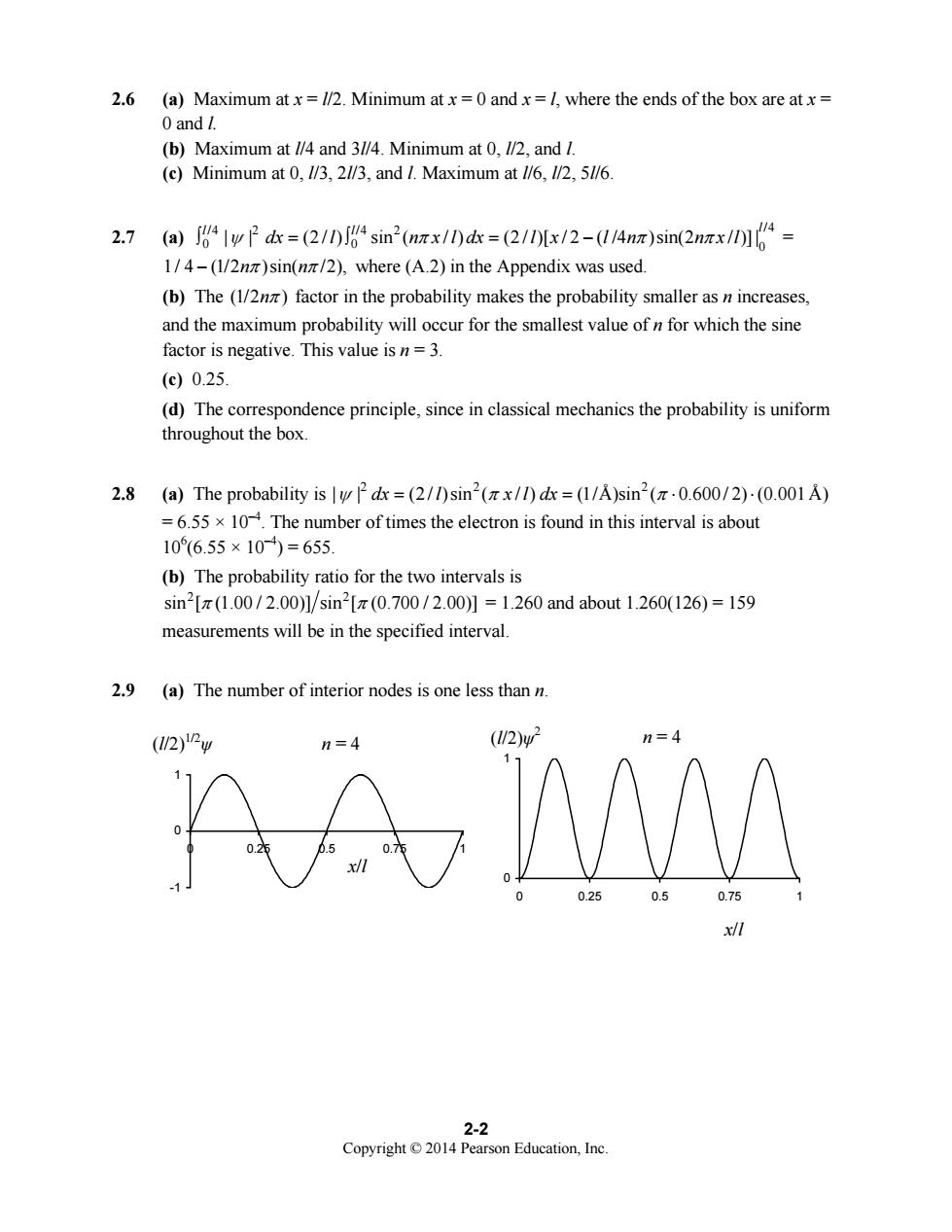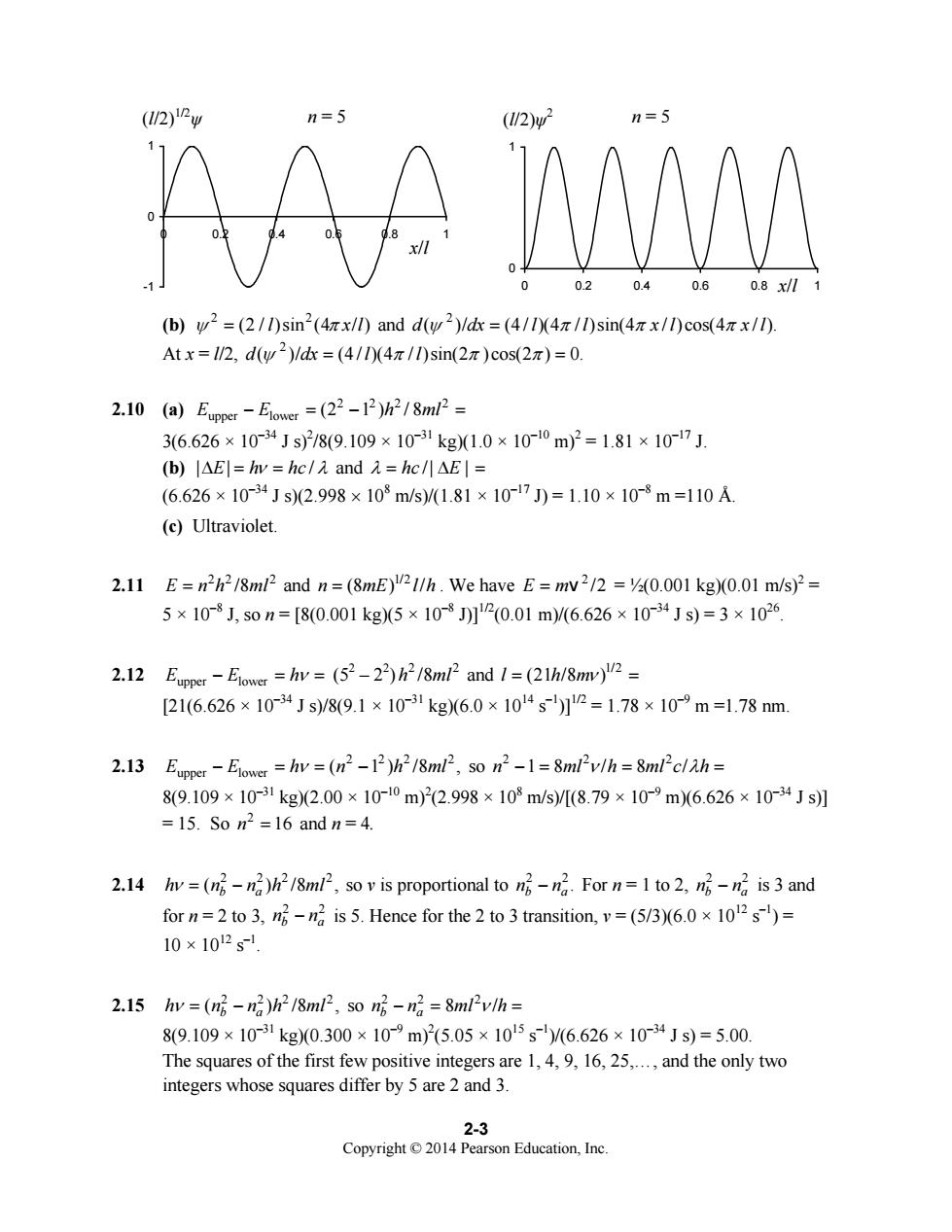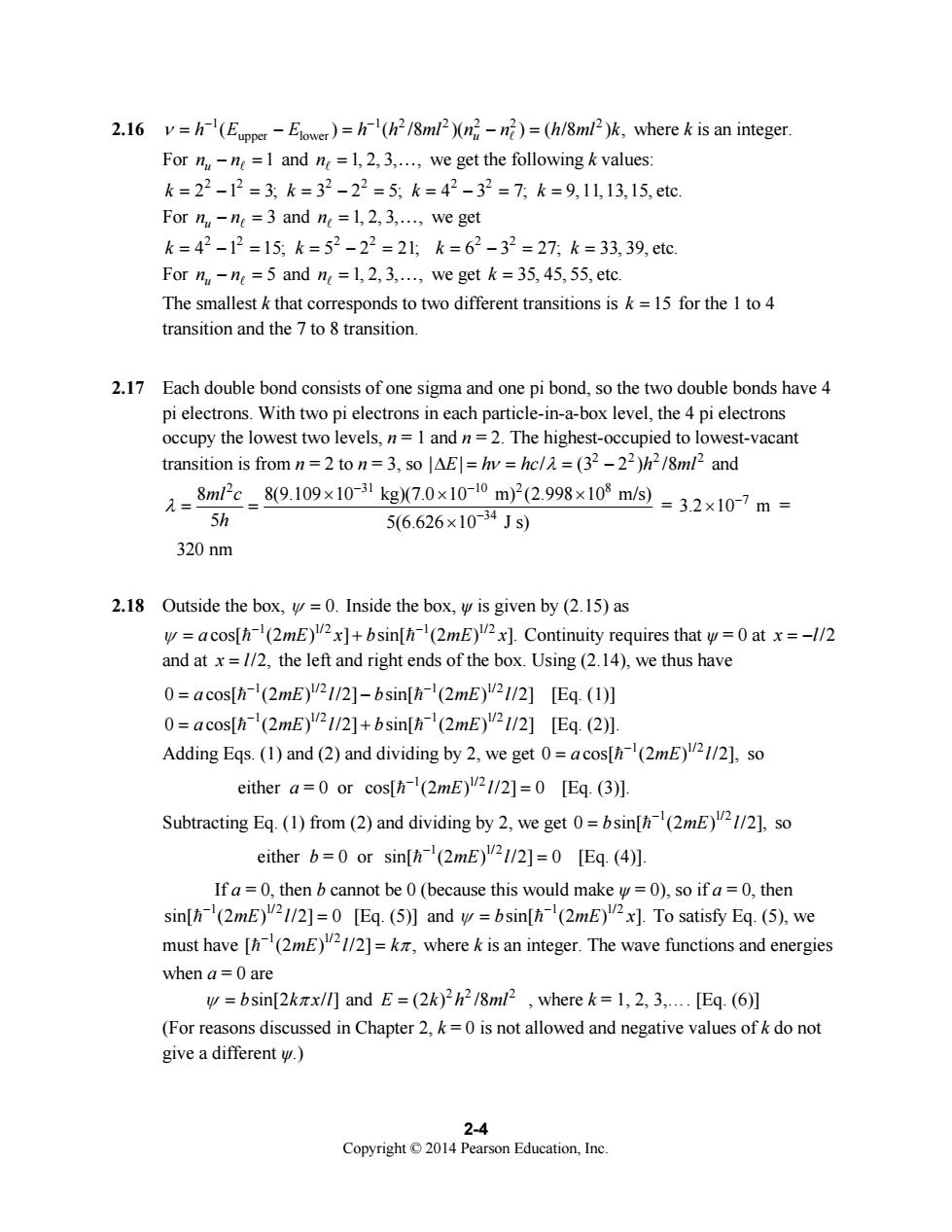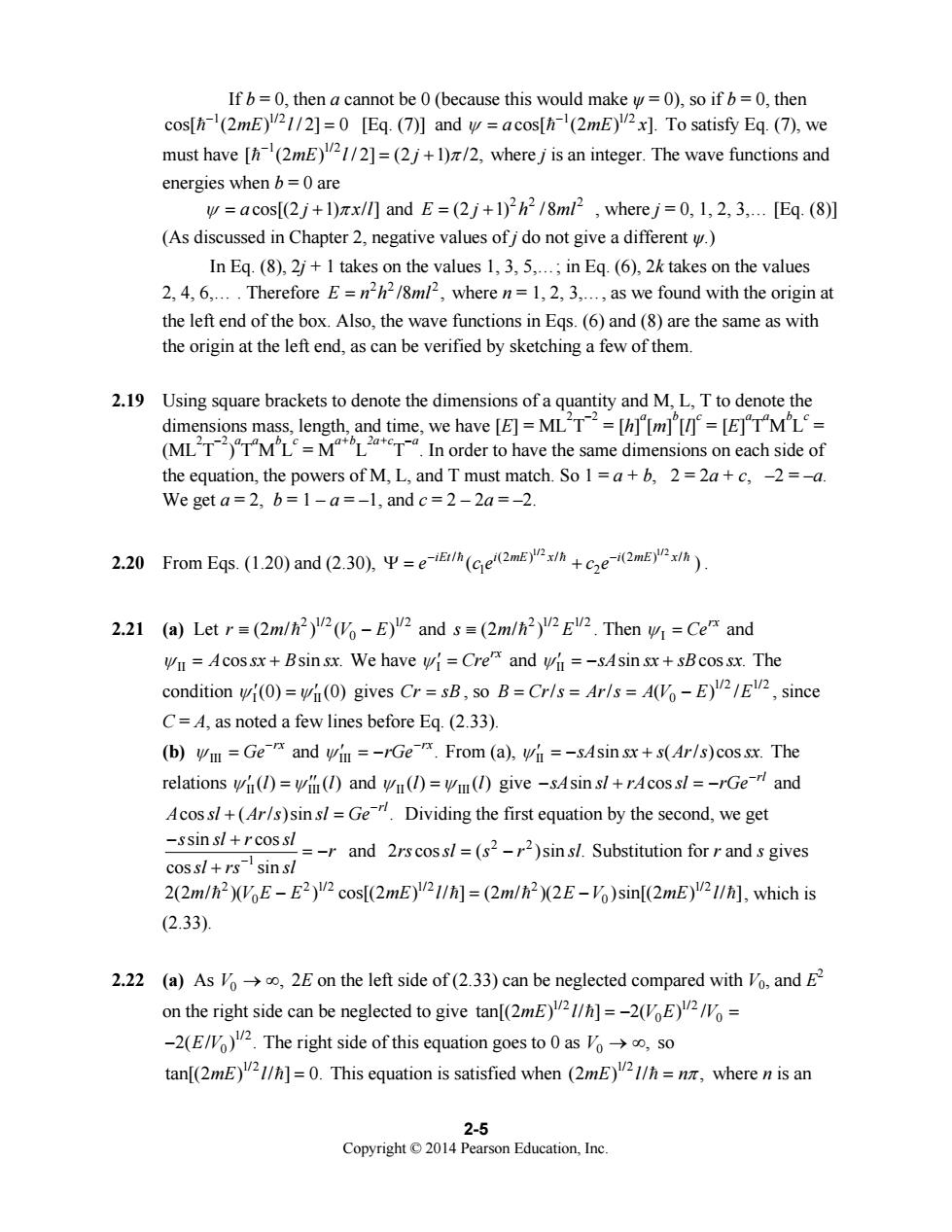
Chapter 2 The Particle in a Box 2.1 (a)The auxiliary equation is s2+s-6=0 and s=[11+2]/2=2 and-3.So y=ce2x+ce-3x (b)Settingx=0 andy=0,we get 0=c+c (Eq.1).Differentiation of y gives y'=2ce2x-3cze-3x.Settingx=0 and y'=1,we have 1=2c-3c2 (Eq.2).Subtracting twice Eq.I from Eq.2,we get 1=-5c2 and c2=-0.2.Equation 1 then gives c=0.2. 2.2 For y"+py'+qy=0,the auxiliary equation is s2+ps+=0=(s-s)(s-s2).where s and s2 are the roots.Comparison with Eq.(2.8)shows that s=2+i and s2=2-i,so the auxiliary equation is 0=(s-2-1)(s-2+1)=s2-4s+5.Therefore p=-4 and g=5.The differential equation is y"-4y+5y=0. 2.3 (a)The quadratic formula gives the solutions of the [Eq.(2.7)]as s=(pp2-4)/2.To have equal roots of the auxiliary equation requires that p2-4=0.Setting =p2/4 in the differential equation (2.6).we have y+py'+(p2/4)y=0(Eq.1).The auxiliary-equation solution is s=-p/2.Thus we must show that y2=xe is the second solution.Differentiation gives -pxe and=-pepxe/4.Substitution in Eq.(1)gives the left side of Eq.(1)as -pe-2+p2xe-m2/4+pe-2-p2xe-m2 2+p2xe-214. which equals zero and completes the proof. (b)The auxiliary equation s2-2s+1=(s-1)2=0 has rootss=1 and s=1.From part (a),the solution is y=ce*+czxe" 2.4 In comparing Eqs.(1.8)and (2.2),y in(2.2)is replaced by x,and x in(2.2)is replaced by t.Therefore x and its derivatives in (18)must occur to the first power to have a linear differential equation.(a)Linear,(b)linear,(c)nonlinear,(d)nonlinear,(e)linear 2.5 (a)F;(b)F;(c)T;(d)F(only solutions that meet certain conditions such as being continuous are allowed as stationary-state wave functions):(e)T. 2-1 Copyright2014 Pearson Education.Inc
Copyright © 2014 Pearson Education, Inc. 2-1 Chapter 2 The Particle in a Box 2.1 (a) The auxiliary equation is 2 s s + − = 6 0 and s = [ 1 1 24] / 2 2 −± + = and –3. So 2 3 1 2 . x x y ce c e− = + (b) Setting x = 0 and y = 0, we get 1 2 0 = c c + (Eq. 1). Differentiation of y gives 2 3 1 2 2 3. x x y ce c e− ′ = − Setting x = 0 and y′ = 1, we have 1 2 12 3 = c c − (Eq. 2). Subtracting twice Eq. 1 from Eq. 2, we get 2 1 5 = − c and 2 c = −0.2. Equation 1 then gives 1c = 0.2. 2.2 For 0, y py qy ′′ ′ + += the auxiliary equation is 2 1 2 s ps q s s s s + +== − − 0 ( )( ), where 1s and 2s are the roots. Comparison with Eq. (2.8) shows that 1s i = 2 + and 2s i = − 2 , so the auxiliary equation is 2 0 ( 2 )( 2 ) 4 5. = −− −+ = − + s is i s s Therefore p = −4 and q = 5. The differential equation is y yy ′′ ′ − 4 5 0. + = 2.3 (a) The quadratic formula gives the solutions of the auxiliary equation 2 s ps q + += 0 [Eq. (2.7)] as 2 s pp q =− ± − ( 4 ) / 2. To have equal roots of the auxiliary equation requires that 2 p q − = 4 0 . Setting 2 q p = /4 in the differential equation (2.6), we have 2 y py p y ′′ ′ ++ = ( /4) 0 (Eq. 1). The auxiliary-equation solution is s p = − /2. Thus we must show that /2 2 px y xe− = is the second solution. Differentiation gives /2 /2 2 /2 px px y e pxe − − ′ = − and /2 2 /2 2 /4. px px y pe p xe − − ′′ =− + Substitution in Eq. (1) gives the left side of Eq. (1) as /2 2 /2 /2 2 /2 2 /2 /4 /2 /4 px px px px px pe p xe pe p xe p xe −−−− − −+ + − + , which equals zero and completes the proof. (b) The auxiliary equation 2 2 ss s − 2 1 ( 1) 0 += − = has roots s = 1 and s = 1. From part (a), the solution is 1 2 . x x y = + c e c xe 2.4 In comparing Eqs. (1.8) and (2.2), y in (2.2) is replaced by x, and x in (2.2) is replaced by t. Therefore x and its derivatives in (1.8) must occur to the first power to have a linear differential equation. (a) Linear; (b) linear; (c) nonlinear; (d) nonlinear; (e) linear. 2.5 (a) F; (b) F; (c) T; (d) F (only solutions that meet certain conditions such as being continuous are allowed as stationary-state wave functions); (e) T

2.6 (a)Maximum at x=1/2.Minimum atx=0 andx=l,where the ends of the box are atx= 0 and (b)Maximum at //4 and 3//4.Minimum at 0,//2,and I. (c)Minimum at /3,2//3,and I.Maximum at /6,5//6 2.7(a))4|w2dk=(2/0Jsin2(nrx/0dr=(2/I0[x/2-(14nz)sin(2nrx/]4= 1/4-(1/2)sin(nz/2),where(A.2)in the Appendix was used (b)The (1/)factor in the probability makes the probability smaller asn increases. and the maximum probability will occur for the smallest value of n for which the sine factor is negative.This value is n=3. (c90.25 (d)The correspondence principle,since in classical mechanics the probability is uniform throughout the box. 2.8 (a)The probability isdx=(2/1)sin2(x/)dx=(1/A)sin2(0.600/2)-(0.001A) =6.55 x 10.The number of times the electron is found in this interval is about 10(6.55×10)=655. (b)The probability ratio for the two intervals is sin2[π(1.00/2.00]/sin2[π(0.700/2.00)】=1.260 and about1.260(126)=159 measurements will be in the specified interval. 2.9 (a)The number of interior nodes is one less than n. (2)Pw (2 2-2 Copyright2014 Pearson Education.Inc
Copyright © 2014 Pearson Education, Inc. 2-2 2.6 (a) Maximum at x = l/2. Minimum at x = 0 and x = l, where the ends of the box are at x = 0 and l. (b) Maximum at l/4 and 3l/4. Minimum at 0, l/2, and l. (c) Minimum at 0, l/3, 2l/3, and l. Maximum at l/6, l/2, 5l/6. 2.7 (a) /4 2 /4 2 /4 0 0 0 | | (2 / ) sin ( / ) (2 / )[ / 2 ( /4 )sin(2 / )] |l l l ∫ =∫ = − ψ π ππ dx l n x l dx l x l n n x l = 1/ 4 (1/2 )sin( /2), − n n π π where (A.2) in the Appendix was used. (b) The (1/2 ) nπ factor in the probability makes the probability smaller as n increases, and the maximum probability will occur for the smallest value of n for which the sine factor is negative. This value is n = 3. (c) 0.25. (d) The correspondence principle, since in classical mechanics the probability is uniform throughout the box. 2.8 (a) The probability is 22 2 | | (2 / )sin ( / ) (1/Å)sin ( 0.600 / 2) (0.001 Å) ψπ π dx l x l dx = = ⋅⋅ = 6.55 × 10–4. The number of times the electron is found in this interval is about 106 (6.55 × 10–4) = 655. (b) The probability ratio for the two intervals is 2 2 sin [ (1.00 / 2.00)] sin [ (0.700 / 2.00)] π π = 1.260 and about 1.260(126) = 159 measurements will be in the specified interval. 2.9 (a) The number of interior nodes is one less than n. -1 0 1 0 0.25 0.5 0.75 1 0 1 0 0.25 0.5 0.75 1 (l/2) n = 4 1/2 ψ x/l n = 4 x/l (l/2)ψ 2

(12)w (/2)w2 n=5 品 08/ (b)w2=(2/1)sin2(4zx/l)and d(w2)/dx=(4/1(4/1)sin(4 x/l)cos(4x/1). Atx=1/2,dw2)/dk=(41I0(4π/0sin(2π)cos(2x)=0. 2.10(al)Eme-Eoe=(22-1P18ml2= 36.626×10-34Js2/8(9.109×10-31kg1.0×10-0m)2=1.81×10-17J. (b)l△El=hw=hc/aand2=hc/I△El= (6.626×10-34Js(2.998×103m/s)/1.81×1017J)=1.10×10-3m=110A (c)Ultraviolet. 2.11 E=n2h2/8ml2 and n=(8mE)2I/h.We have E=mv2/2 =(0.001 kg)(0.01 m/s)2= 5×10-8J,s0n=[8(0.001kg5×10-8J2(0.01m)/6.626×10~34Js)=3×1026 2.12Eper-Elower=hv=(52-2)h2/8m2and1=(21h/8m)2= [21(6.626×1034Js)/8(9.1×10-1kg6.0×1014s]2=1.78×10m=1.78nm 2.13 Euppe:-Elower=hv=(nh218ml2,so n2-1=8mlv/h=8mlclah= 8(9.109×10-31kg(2.00×1010m)2(2.998×108m/s)/(8.79×10m)6.626×10-34Js】 =15.S0m2-16andn=4. 2.14 hv =(np-n2)h2/8ml2,so v is proportional to nng.For n=I to 2.mn is 3 and for n=2 to 3.n is 5.Hence for the 2 to 3 transition,v=(5/3)(6.0x 102s)= 10×102s- 2.15 hy =(np-n2)h2 /8ml2,so np-n2 8ml2v/h 89.109×10-1kg0.300×109m)5.05×105s)/6.626×1034Js)=5.00. The squares of the first few positive integers are 1,4,9,16,25,.and the only two integers whose squares differ by 5 are 2 and 3 2-3 Education.Inc
Copyright © 2014 Pearson Education, Inc. 2-3 -1 0 1 0 0.2 0.4 0.6 0.8 1 0 1 0 0.2 0.4 0.6 0.8 1 (b) 2 2 ψ = (2 / )sin (4 / ) l xl π and 2 d dx l l x l x l ( )/ (4 / )(4 / )sin(4 / )cos(4 / ). ψ ππ π = At x = l/2, 2 d dx l l ( )/ (4 / )(4 / )sin(2 )cos(2 ) 0. ψ π ππ = = 2.10 (a) 2 22 2 upper lower E E h ml − =− = (2 1 ) / 8 3(6.626 × 10–34 J s)2 /8(9.109 × 10–31 kg)(1.0 × 10–10 m)2 = 1.81 × 10–17 J. (b) || / Δ= = E h hc ν λ and /| | λ = hc EΔ = (6.626 × 10–34 J s)(2.998 × 108 m/s)/(1.81 × 10–17 J) = 1.10 × 10–8 m =110 Å. (c) Ultraviolet. 2.11 22 2 E n h ml = /8 and 1/2 n mE l h = (8 ) / . We have 2 E m= v /2 = ½(0.001 kg)(0.01 m/s)2 = 5 × 10–8 J, so n = [8(0.001 kg)(5 × 10–8 J)]1/2(0.01 m)/(6.626 × 10–34 J s) = 3 × 1026. 2.12 EEh upper lower − == ν (52 – 22 ) 2 2 h ml /8 and 1/2 l hm = (21 /8 ) ν = [21(6.626 × 10–34 J s)/8(9.1 × 10–31 kg)(6.0 × 1014 s–1)]1/2 = 1.78 × 10–9 m =1.78 nm. 2.13 2 22 2 upper lower E E h n h ml − == − ν ( 1 ) /8 , so 22 2 n ml h ml c h −18 / 8 / == = ν λ 8(9.109 × 10–31 kg)(2.00 × 10–10 m)2 (2.998 × 108 m/s)/[(8.79 × 10–9 m)(6.626 × 10–34 J s)] = 15. So 2 n = 16 and n = 4. 2.14 2 22 2 ( ) /8 , b a h n n h ml ν = − so ν is proportional to 2 2. b a n n − For n = 1 to 2, 2 2 b a n n − is 3 and for n = 2 to 3, 2 2 b a n n − is 5. Hence for the 2 to 3 transition, ν = (5/3)(6.0 × 1012 s–1) = 10 × 1012 s–1. 2.15 2 22 2 ( ) /8 , b a h n n h ml ν = − so 22 2 8 / b a n n ml h − = = ν 8(9.109 × 10–31 kg)(0.300 × 10–9 m)2 (5.05 × 1015 s–1)/(6.626 × 10–34 J s) = 5.00. The squares of the first few positive integers are 1, 4, 9, 16, 25,., and the only two integers whose squares differ by 5 are 2 and 3. n = 5 (l/2)ψ n = 5 2 (l/2)1/2 ψ x/l x/l

2.16v=h(Eupper -Elower)=h(h2/8ml2)(n-m)=(h/8ml2)k,where k is an integer For n=1 and n=1,2.3.we get the following k values: k=22-12=3k=32-22=5k=42-32=7,k=9,11,13,15,tc For n-n =3 and n =1,2,3.we get k=42-12=15,k=52-22=21k=62-32=27,k=33,39,tc For n -n=5 and n=1,2.3.,we get k=35,45,55,etc. The smallest k that corresponds to two different transitions is k=15 for the I to 4 transition and the 7 to 8 transition 2.17 Each double bond consists of one sigma and one pi bond,so the two double bonds have 4 pi electrons.With two pi electrons in each particle-in-a-box level,the 4 pi electrons occupy the lowest two levels,n=1 and n=2.The highest-occupied to lowest-vacant transition is from n=2 to n=3,so AEl=hv hc/=(32-22)h2/8ml2 and A.8m.s9109x10"kgX70x1o0m2298x10m的-32x107m= 5h 56.626×1034Js) 320nm 2.18 Outside the box,=0.Inside the box,w is given by (2.15)as =acos[(2mE)x]+bsin[h(2mE)x]Continuity requires that =0at x=-112 and at x=1/2,the left and right ends of the box.Using (2.14),we thus have 0=acos[h'(2mE)21/2]-bsin[h'(2mE)21/2]Eq.(1] 0=acos[h'(2mE)21/2]+bsim[h'(2mE)21/2]Eq.(2l Adding Eqs.(1)and(2)and dividing by 2,we get 0=acos[h(2mE)21/2].so either a=0 or cos[h(2mE)21/]=0 [Eq.(3)] Subtracting Eq.(1)from(2)and dividing by 2.we get =bsin[h(2mE)21/].so either b=0 or sin[h (2mE)1/]=0 [Eq.(4)]. If a=0,then b cannot be 0(because this would make =0),so ifa=0,then sin[h-(2mE)21]=0 [Eq.(5)]and w=bsin[h(2mE)2x].To satisfy Eq.(5).we must have [(2mE)1]=k where k is an integer.The wave functions and energies when a=0 are yw=bsin2kπx/l川andE=(2k)2h2/8ml2,wherek=1,2,3,.Eq.(6】 (For reasons discussed in Chapter2,not allowed and negative values of k do not give a different w.) 24 Copyright2014 Pearson Education.Inc
Copyright © 2014 Pearson Education, Inc. 2-4 2.16 1 12 2 2 2 2 upper lower ( ) ( /8 )( ) ( /8 ) , u ν h E E h h ml n n h ml k − − = − = −= A where k is an integer. For 1 u n n − =A and 1, 2, 3, , nA = . we get the following k values: 22 2 2 2 2 kk k k = −= = − = = − = = 2 1 3; 3 2 5; 4 3 7; 9,11,13,15, etc. For 3 u n n − =A and 1, 2, 3, , nA = . we get 22 2 2 k k = −= = − = 4 1 15; 5 2 21; 2 2 k k =−= = 6 3 27; 33, 39, etc. For 5 u n n − =A and 1, 2, 3, , nA = . we get k = 35, 45, 55, etc. The smallest k that corresponds to two different transitions is k = 15 for the 1 to 4 transition and the 7 to 8 transition. 2.17 Each double bond consists of one sigma and one pi bond, so the two double bonds have 4 pi electrons. With two pi electrons in each particle-in-a-box level, the 4 pi electrons occupy the lowest two levels, n = 1 and n = 2. The highest-occupied to lowest-vacant transition is from n = 2 to n = 3, so 2 22 2 | | / (3 2 ) /8 Δ= = = − E h hc h ml ν λ and 2 31 10 2 8 34 8 8(9.109 10 kg)(7.0 10 m) (2.998 10 m/s) 5 5(6.626 10 J s) ml c h λ − − − ×× × = = × = 7 3.2 10 m − × = 320 nm 2.18 Outside the box, 0. ψ = Inside the box, ψ is given by (2.15) as 1 1/2 1 1/2 ψ a mE x b mE x cos[ (2 ) ] sin[ (2 ) ]. − − = + = = Continuity requires that ψ = 0 at x = −l/2 and at x = l/2, the left and right ends of the box. Using (2.14), we thus have 1 1/2 1 1/2 0 cos[ (2 ) /2] sin[ (2 ) /2] a mE l b mE l − − = − = = [Eq. (1)] 1 1/2 1 1/2 0 cos[ (2 ) /2] sin[ (2 ) /2] a mE l b mE l − − = + = = [Eq. (2)]. Adding Eqs. (1) and (2) and dividing by 2, we get 1 1/2 0 cos[ (2 ) /2], a mE l − = = so either a = 0 or 1 1/2 cos[ (2 ) /2] 0 mE l − = = [Eq. (3)]. Subtracting Eq. (1) from (2) and dividing by 2, we get 1 1/2 0 sin[ (2 ) /2], b mE l − = = so either b = 0 or 1 1/2 sin[ (2 ) /2] 0 mE l − = = [Eq. (4)]. If a = 0, then b cannot be 0 (because this would make ψ = 0), so if a = 0, then 1 1/2 sin[ (2 ) /2] 0 mE l − = = [Eq. (5)] and 1 1/2 ψ b mE x sin[ (2 ) ]. − = = To satisfy Eq. (5), we must have 1 1/2 [ (2 ) /2] , mE l kπ − = = where k is an integer. The wave functions and energies when a = 0 are sin[2 / ] ψ = b k xl π and 22 2 E k h ml = (2 ) /8 , where k = 1, 2, 3,. [Eq. (6)] (For reasons discussed in Chapter 2, k = 0 is not allowed and negative values of k do not give a different ψ.)

If b=0.then a cannot be (because this would make=0).so ifb=0.then cos(2m]=0[Eq.(7)and acos(2mE)x]To satisfy Eq.()we must have [(2mE)21/2]=(2j+1/2.where jis an integer.The wave functions and energies when b=0 are w=acos[(2j+1)xx/I]and E=(2j+1)h2/8ml2,wherej=0,1,2,3.[Eq.(8)] (As discussed in Chapter 2,negative values ofjdo not give a different.) In Eq.(8),j+I takes on the values 1,3,5.in Eq.(6),2k takes on the values 2.4,6.Therefore E=n2h2/8ml2,where n=1,2,3.,as we found with the origin at the left end of the box.Also,the wave functions in Eqs.(6)and(8)are the same as with the origin at the left end,as can be verified by sketching a few of them 2.19 Using square brackets to denote the dimensions of a quantity and M.L.Tto denote the s,length,and time.we have []ML[ML In order to have the same dimensions on each side of the equation,the powers of M.L,and T must match.o1+2+c. We geta=2.b=1-a=-1,andc=2-2a=-2. 2.0 From Eqs.(120)and (20).() 2.21 (a)Let r=(2m/h2)2Vo-E)2 and s=(2m/h2)E2.Then w=Ce and Wu Acossx+Bsin sx.We have wi=Cre and wi =-sAsin sx+sBcos sx.The condition wi(0=wi(0)gives Cr=sB,so B=Cr/s=Ar/s=A(Vo-E)2/E2,since C=A,as noted a few lines before Eq.(2.33). (b)wm =Ge and win =-rGe.From(a).wi =-sAsin sx+s(Ar/s)cossx.The relations wi()=i (and wn()=wm(1)give-sAsinsl+rAcossl=-rGe-and Acossl+(Ar/s)sinsl=Ge Dividing the first equation by the second,we get -ssins/+rcossl cossl+rssinsl =rand 2rscoss/=(s2-r2)sinsl.Substitution for rand s gives 2(2m/h2)(VoE-E2)2 cos[(2mE)]=(2m/h2(2E-Vo)sin[(2mE)2I/h],which is (2.33) 2.22 (a)As o 2E on the left side of (2.33)can be neglected compared with Vo,and on the right side can be neglected to give tan[(2mE)]=-2(VE)= 2(E/V).The right side of this equation goes toas so tan[(2mE)/=0.This equation is satisfied when (2mE)2I/h=nz,where n is an 2-5 Education.Inc
Copyright © 2014 Pearson Education, Inc. 2-5 If b = 0, then a cannot be 0 (because this would make ψ = 0), so if b = 0, then 1 1/2 cos[ (2 ) / 2] 0 mE l − = = [Eq. (7)] and 1 1/2 ψ a mE x cos[ (2 ) ]. − = = To satisfy Eq. (7), we must have 1 1/2 [ (2 ) / 2] (2 1) /2, mE l j π − = = + where j is an integer. The wave functions and energies when b = 0 are ψ = + a j xl cos[(2 1) / ] π and 22 2 E = + (2 1) / 8 j h ml , where j = 0, 1, 2, 3,. [Eq. (8)] (As discussed in Chapter 2, negative values of j do not give a different ψ.) In Eq. (8), 2j + 1 takes on the values 1, 3, 5,.; in Eq. (6), 2k takes on the values 2, 4, 6,. . Therefore 22 2 E = n h ml /8 , where n = 1, 2, 3,., as we found with the origin at the left end of the box. Also, the wave functions in Eqs. (6) and (8) are the same as with the origin at the left end, as can be verified by sketching a few of them. 2.19 Using square brackets to denote the dimensions of a quantity and M, L, T to denote the dimensions mass, length, and time, we have [E] = ML2 T–2 = [h] a [m] b [l] c = [E] a T a Mb L c = (ML2 T–2) a T a Mb L c = Ma+bL 2a+cT–a. In order to have the same dimensions on each side of the equation, the powers of M, L, and T must match. So 1 = a + b, 2 = 2a + c, –2 = –a. We get a = 2, b = 1 – a = –1, and c = 2 – 2a = –2. 2.20 From Eqs. (1.20) and (2.30), 1/2 1/2 / (2 ) / (2 ) / 1 2 ( ) iEt i mE x i mE x e ce c e − − Ψ= + == = . 2.21 (a) Let 2 1/2 1/2 0 r m VE ≡ − (2 / ) ( ) = and 2 1/2 1/2 sm E ≡ (2 / ) = . Then I rx ψ = Ce and II ψ = + A sx B sx cos sin . We have I rx ψ′ = Cre and II ψ′ = − + sA sx sB sx sin cos . The condition I II ψ′ ′ (0) (0) =ψ gives Cr sB = , so 1/2 1/2 0 B ===− Cr s Ar s A V E E / / ( )/ , since C = A, as noted a few lines before Eq. (2.33). (b) III rx ψ Ge− = and III . rx ψ rGe− ′ = − From (a), II ψ′ = − + sA sx s Ar s sx sin ( / )cos . The relations II III ψ′ ′′ () () l l =ψ and II III ψ () () l l =ψ give sin cos rl sA sl rA sl rGe− − + =− and cos ( / )sin . rl A sl Ar s sl Ge− + = Dividing the first equation by the second, we get 1 sin cos cos sin s sl r sl r sl rs sl − − + = − + and 2 2 2 cos ( )sin . rs sl s r sl = − Substitution for r and s gives 2 2 1/2 1/2 2 1/2 0 0 2(2 / )( ) cos[(2 ) / ] (2 / )(2 )sin[(2 ) / ] m V E E mE l m E V mE l = == = − =− , which is (2.33). 2.22 (a) As 0 V → ∞, 2E on the left side of (2.33) can be neglected compared with V0, and E2 on the right side can be neglected to give 1/2 1/2 0 0 tan[(2 ) / ] 2( ) / mE l V E V = = − = 1/2 0 −2( / ) . E V The right side of this equation goes to 0 as 0 V → ∞, so 1/2 tan[(2 ) / ] 0. mE l = = This equation is satisfied when 1/2 (2 ) / , mE l n = = π where n is an